跨文化交际中的个人主义与集体主义
从跨文化交际的角度解析中西方酒文化

从跨文化交际的角度解析中西方酒文化摘要:本文从美国知名学者、《跨文化传播》的作者之一萨默瓦归纳的跨文化交际的三个方面,即语言过程(包括语言及思维模式)、非语言过程(包括非语言行为、时间观念和对于空间的使用)、观点(包括价值观、世界观和社会组织)出发,对中西方酒文化进行一系列对比,从酒在不同文化中的意义、作用以及人们在饮酒活动中的语言、行为和准则进行了研究。
然后进一步探究导致这些差异产生的相尖文化因素,诸如价值观、宗教信仰、思维方式等。
矢键词:跨文化交际;中国酒文化;西方酒文化;观念中图分类号:G04文献标识码:A文章编号:1673-2596 (2016) 04-0126- 03酒文化就是围绕着酒所产生的一系列物质的、精神的、行为的、技艺的、习俗的、心理的现象总和。
由于历史背景、社会规范、传统习俗、价值观念、思维模式和生活习惯等的不同,中西方的酒文化风格迥异[1]°20世纪70年代,美国知名学者、《跨文化传播》的作者之一拉里A萨默瓦将跨文化交际归纳为三个方面,即观点(包括价值观、世界观和社会组织)、语言过程(包括语言及思维模式)、非语言过程(包括非语言行为、时间观念和对于空间的使用)。
本文也将从以上三个方面来解读中西方酒文化、跨文化交际场合中酒的语言差异(一)汉字“酒”与英语的对应词酒,在中国被赋予了极其强烈的感情色彩。
东汉人许慎在《说文解字》里说:“酒,就也。
所以就人性之善恶也……n 酒能让人至善至美,也能让人荒淫无度。
鉴于此,酒便有了褒贬不同的称呼,如天禄、欢伯、福水、魔浆、祸泉等。
在英语中,酒是指用谷物、蔬果等含淀粉或糖的物质经过发酵制成的含乙醇的饮料,如葡萄酒、白酒等。
因此,英语中表示酒的词语有许多。
(二)英汉语言中的表达方式在中国历史传说、典故中,有许多都与酒文化有矢。
例如由饮酒直接引申出的汉语四字表达:“酒肉朋友”,翻译成英语“ fair-weather friends ”[2]。
《跨文化交际》_名词解释
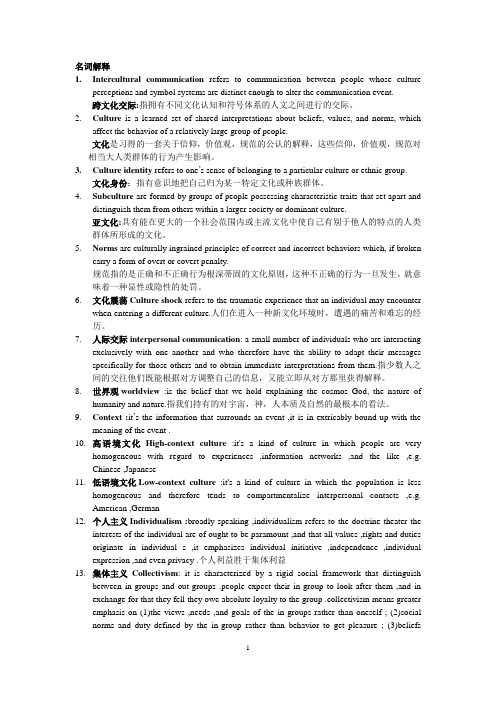
名词解释1.Intercultural communication refers to communication between people whose cultureperceptions and symbol systems are distinct enough to alter the communication event.跨文化交际:指拥有不同文化认知和符号体系的人文之间进行的交际。
2.Culture is a learned set of shared interpretations about beliefs, values, and norms, whichaffect the behavior of a relatively large group of people.文化是习得的一套关于信仰,价值观,规范的公认的解释,这些信仰,价值观,规范对相当大人类群体的行为产生影响。
3.Culture identity refers to one’s sense of belonging to a particular culture or ethnic group.文化身份:指有意识地把自己归为某一特定文化或种族群体。
4.Subculture are formed by groups of people possessing characteristic traits that set apart anddistinguish them from others within a larger society or dominant culture.亚文化:具有能在更大的一个社会范围内或主流文化中使自己有别于他人的特点的人类群体所形成的文化。
5.Norms are culturally ingrained principles of correct and incorrect behaviors which, if brokencarry a form of overt or covert penalty.规范指的是正确和不正确行为根深蒂固的文化原则,这种不正确的行为一旦发生,就意味着一种显性或隐性的处罚。
跨文化交际中的个人主义与集体主义

跨文化交际中的个人主义与集体主义摘要:霍夫斯泰德1980年通过实证调查研究提出了文化维度理论,其中包括四项文化维度,分别是:权利主义、个人主义/集体主义、不确定性规避、男性倾向与女性倾向。
近年来,部分学者却对霍夫斯泰德的二元个人主义/集体主义理论产生了质疑。
他们认为个人主义与集体主义在文化维度上发生了变化,个人主义价值观并非与集体主义价值观处于对立两极,而是呈现出s维度的特征。
关键词:个人主义;集体主义; s维度论价值观念与文化是密切相融的,不同文化背景下的人会持有不同的价值观念。
集体主义与个人主义,作为不同文化的产物,集中体现了东西方价值观念的差异。
随着跨文化交际的发展和经济文化等方面实现全面的全球化,在一个文化背景下,可能存在多种而不是唯一的价值观念,当然在多种的价值观念中,会有一种价值观是作为主流价值观存在的,并且与其他的价值观共存。
二、s维度论的内涵霍夫斯泰德1980年出版了culture’s consequences,在这本书中总结了比较文化差异的四大维度:个人主义/集体主义,权力差距,不确定性规避,男性倾向与女性倾向。
其中个人主义,集体主义一直受到广大学者广泛的关注和运用,很多学者一直认同霍夫斯泰德的二元个人主义/集体主义维度,认为个人主义和集体主义是文化维度上的两极,非此即彼。
然而1990年,当安迪斯对这两种倾向进行实证性研究时发现,个人主义和集体主义并没有表现出必然的相关性。
他的研究强调了文化内的多样性,即在同一文化背景的人群中一部分表现得既个人主义又集体主义,一部分既不个人主义又不集体主义,还有一部分要么个人主义要么集体主义。
而近年来,部分学者认为个人主义与集体主义在这一文化维度上发生了变化,并呈现出s维度的特征。
太极理论和太极图所表征的是事物阴阳平衡、相互转化、相互渗透的原理。
跨文化交际体系中的个人主义与集体主义同样也处于一个太极之中,它们是冲突与和谐的统一体,二者之间有着相互依存和相互制约的关系,也就是常说的“相生相克”。
跨文化心理学研究个人主义与集体主义的心理差异

跨文化心理学研究个人主义与集体主义的心理差异在跨文化心理学中,个人主义与集体主义是两个核心概念,用以解释不同文化背景下的心理差异。
个人主义强调个体的独立性、自主性和个人权利,而集体主义则强调群体的亲密关系、协作和集体责任。
本文将探讨个人主义与集体主义心理差异的影响和表现。
一、价值观差异个人主义和集体主义在价值观方面存在显著差异。
个人主义文化中,个体的权利和自由被重视,个人追求幸福、独立和竞争优势。
相对地,集体主义文化中,个体被视为整个群体的一部分,在群体的福祉和和谐关系方面具有更高的优先级。
个人主义文化倾向于追求个体的成就和成功,在价值观层面上更加关注个人的权利和自由。
例如,西方文化中的个体主义者可能更加重视个人意愿的实现,追求自由表达和追求个人利益的最大化。
相反,集体主义文化更加强调群体利益和集体感知,重视群体的合作和和谐。
例如,亚洲文化中的集体主义者可能更注重社区和家庭关系的维护,愿意为群体利益而做出个人的牺牲。
二、自我概念差异个人主义和集体主义文化在自我概念上也存在差异。
个人主义文化倾向于以个人为中心,强调独立自主的自我概念。
而集体主义文化更加强调个体与群体之间的相互依存和关系。
在个人主义文化中,个体更倾向于将自己与他人区分开来,强调个人的内在特质和能力。
相对地,在集体主义文化中,个体的自我概念更多地与群体和社会角色相关联。
个体的身份和自我概念通常会通过群体和他人的认可和参照来建立和维系。
三、决策方式差异个人主义和集体主义文化在决策方式上也存在显著差异。
个人主义文化倾向于强调个体的自主性和个人选择权,个体更多地参与决策过程。
相对地,在集体主义文化中,决策过程更加强调对群体的考虑和共识。
个人主义文化中的决策过程通常更注重个人权益和利益的最大化,个体更独立地做出决策。
相反,集体主义文化更注重团体的意见和共识,在决策过程中更加注重群体的利益和合作。
四、恩怨观念与行为差异个人主义和集体主义文化在对待恩怨关系和行为准则上也存在差异。
跨文化交际

跨文化交际跨文化交际技巧参考答案定义题1、Intercultural communication跨文化交际P3There are three kinds of things you need to learn if you want to be able to communicate effectively with Westerners. First, you need to learn a foreign language, usually English. Second, you should learn as much as possible about Western cultures. However, studying English language and Western culture is not enough. You should also learn something about what happens when people from different cultures try to communicate with each other —in other words, "intercultural communication."2、Individualist个人主义Individualist culture is one in which people tend to view themselves as individuals and emphasize the needs of individuals. In general, Western culture tends to be individualist. They view themselves as independent of collectives; are primarily motivated by their own preferences, needs, rights, and the contacts they have established with others; give priority to their personal goals over the goals of others; and emphasize rational analyses of the advantages and disadvantages to associating with others.3、Collectivist集体主义Collectivist culture is one in which people tend to view themselves as members of groups (families, work units, tribes, nations), and usually consider the needs of the group to be more important than the needs of individuals. Most Asian cultures, including China's, tend to be collectivist. People see themselves as parts of one or more collectives; are primarily motivated by the norms of, and duties imposed by, those collectives; are willingto give priority to the goals of these collectives over their own personal goals; and emphasize their connectedness to members of these cultures.4、public behavior /private behaviorPublic behavior is the behavior in public settings, such as in work places, shops and so on. Private behavior is the behavior in private life, such as when you are at home or with your family and so on. Both individualist and collectivist cultures make a distinction between public life and private life. However, individualist Western cultures tend to make an especially clear and firm distinction between the public and private, and generally feel that these two aspects of life should be kept separate from each other. In other words, Westerners tend to believe that having a personal relationship with someone should not affect how you treat that person in public, work-related situations.5、Generalizations文化的笼统性P26It’s a neutral word which is a general conclu sion drawing from particular examples or evidence.( In any culture group there will be many different beliefs represented, but most of the members of the group will tend in a certain direction. It is this "preponderance of belief," — not uniform acceptance of a given belief —that gives a culture its nature and is the legitimate subject of generalization. People in the same culture share many things in common, such as shared knowledge, shared values, shared perspectives, shared beliefs, shared behavior.)6、Stereotypes老套思路P26It is a derogatory word. It means that image, idea, character that has become fixed or standardized in a conventional form without individuality and is therefore false and shallow.( A way ofthinking that does not acknowledge internal difference within a group, and does not acknowledge exception to its general rules or principles. These stereotypes are often based on accurate information but the problem is that stereotypes blind us to other, equally important aspects of a person's character or behavior. Stereotypes may have been created by direct experience with only one or two people from a particular group. Others are probably based on the second-hand information and opinion, output from the mass media, and general habits of thinking; they may even have been formed without any direct experience with individuals from the group. Yet many people are prepared to assume that stereotype is an accurate representation of all members of a specific group.)7、Hierarchy不同的等级权利P33Different in rank and power----equalityEvery society has hierarchy to some degree. In other words, some people have higher rank and more power than others, perhaps because they are older, stronger, wealthier, or have some kind of official position. On the other hand, however, most modern societies also believe that equality is a virtue, at least to some extent. So each culture needs to find its own balance between hierarchy and equality.1) Westerners generally have less respect for seniority — age, position and so forth — than would be the case in a collectivist culture.2) Western societies often try to limit the power of government officials.3) Westerners tend to have a somewhat suspicious and even negative view of power and authority.8、Culture shock文化冲击P36Culture shock is a feeling of being confused and overwhelmed by life in another culture. People who experience culture shock often feel fatigued, impatient and irritable. They may also begin trying to avoid interaction with foreigners, and even become increasingly critical and hostile toward them. Foreigners in China sometimes experience culture shock — and so do Chinese who go to live in other countries.9、Projected cultural similarity P48Projected cultural similarity is the tendency to assume that people from other cultures basically think and feel more the same way we do. In other words, we sometimes assume that while foreigners may look different, dress differently, and speak different languages, "inside we are all more or less the same". People from different culture assume they understand each other instead of asking each other what they think. Because they each expect the other person to react more or less the same way they would, they don't check to see whether or not the other person actually has the same feelings and reactions they would.10、loose culture and tight cultureLoose culture doesn’t demand a high degree of conformity. In loose cultures, people have a relatively wide range of views as to what is considered normal behavior. They also tend to be relatively tolerant of behavior that does not conform to cultural norms. And there is less pressure on individuals within the same culture to behave the same way most other people in the culture do. Tight culture: expect a relatively high degree of conformity. There is a clear consensus as to what is and is not acceptable behavior and there is more pressure on people to conform to the norms of the culture.Here is an example of how people deal with people who areborn left-handed. In tight cultures, children who favor their left hand are encouraged or even forced to use their right hand instead, and the percentage of left-handed people in the adult population is much smaller.11、Ethnocentrism 民族优越感P59"Ethnocentrism" is the tendency to think of one’s own cultu re as being at the center of the world and identify with one’s in-group and to evaluate out-groups and their members according to its standards; in other words, to assume that one’s own culture's way of thinking and acting is more natural, normal, and correct than the way people from other cultures think and act, and tend to view one’s own cultural values and ways of doing things as more real, or as the ‘right’ and natural values and ways of doing things.12、In-groups and out-groups P70In-Groups: “In-groups”a re the people we have the most in common with and identify most closely with, such as our family, classmates, or co-workers. We also have larger in-groups such as people who are from our own region, religious group, ethnic group, or nation. In-groups are groups of people about whose welfare we are concerned, with whom we are willing to cooperate without demanding equitable returns, and separation from whom leads to discomfort or even pain. Out-groups: out groups are those groups of people who we do not identify with---people from other families, regions, ethnic groups, or nations. Out-groups are groups of people about whose welfare we are not concerned, and groups with whom we require an equitable return in order to cooperate.13、war stories P80The term “war stories” originally referred to the kinds ofstories soldiers would tell after experiences in battle. Now “war stories” refers more generally to any stories people tell after strange or stressful experiences, including stories about unusual encounters with foreigners.14 low context/ high context1.Low context: the way westerners communicate tends to be relatively explicit and direct. In other words, Westerners tend to put most of their ideas and feelings into words, and then state their ideas and feeling s plainly and openly. It’s generally considered a good thing to get to the point and say what you mean, and it’s largely the speaker’s responsibility to ensure that his/her massage is stated in a way that is clear and easy to understand. --low context, people are expected to pay more attention to the words used in communication than to context in which things are said. They expect others to ‘take them at their words’-to believe that what they say is what they mean.2.High context: in collectivist cultures, people tend to communicate in a way that is more indirect and subtle, and listeners are expected to take more responsibility for inerpreting messages correctly. -High context, people are expected to pay much attention to the context in which communication takes place- who the speaker is, where and why the conversation is taking place, body language, and so forth-and when people interpret what others mean, they often give more weight to the context than to the actual words said. People in high context often view direct, explicit communication as unsophisticated or even rude.问答题1、Why would intercultural communication be more difficult than the communication between people from the same culture?(Why is it hard to learn a foreign culture?)先定义intercultural communication1)Some stumbling blocks2)Assuming more cultural similarities leads to misunderstanding3)Language difference4)Misinterpreting verbal communication and body language from other country5)Stereotype and preconceptions6)Evaluate before really understanding7)Interact with foreigners stressfully and suffer from culture shock8)Tend to generalize or simplify9)Tend to define groups by a few key characteristic10)Assume everyone is similar2、What are some differences between an individualist culture and a collectivist one?Are all Westerners individual ? Are all Chinese collectivist?先定义individualist 和collectivist(1) Westerners tend to believe that people should rely on themselves as much as possible- and they usually expect other people to do the same. In contrast, people in collectivist cultures generally feel they have a right to expect help from other members of their groups(family, classmates, and so forth), and they also tend to feel they have an obligation to help other members of their groups.(2) Westerners generally feel that the rights of individuals should not be subordinated to the needs of a larger group, or at least that individuals should have to right to decide for themselves whether to sacrifice their benefit for the sake of thegroup.(3) Westerners tend to believe that individuals should make decisions for themselves and that individuals should take credit and responsibility for what they have personally done.(4) A final difference lies in the way people in difference cultures vi ew the idea of “individualism”. Westerners tend to view individualism as a good thing. In English, the word “individualism”has no negative connotation. In fact, its connotation is somewhat positive. In contrast, the Chinese term for “individualism” , often has a somewhat negative connotation, and is sometimes used as a synonym for “selfishness”.3、What are the different virtues Chinese and Americans emphasize most?Virtue is a positive trait or quality deemed to be morally good and thus is valued as a foundation of principle and good moral being.Chinese: formality/ hierarchy/ industriousness/ being filial/ hard work/ modesty/ thrifty Americans: activity-dominant/ equality/ motivation based on achievement/ the world is material rather than spiritual/ optimistic/ individualist/ materialism/ success/ humanitarianism4、How do Western cultures view the relationship between public and private life?先定义public: work, national duty; private: home, family, personal friendshipsWestern cultures tend to make an especially clear and firm distinction between the public and private, and generally feel that these two aspects of life should be kept separate from each other. In other words, westerners tend to believe that having apersonal relationship with someone should not affect how you treat that person in public, work-related situations. (In fact, some westerners try to avoid mixing work and play completely, and keep their circle of work acquaintances quite separate from their circle of personal friends)Of course, personal relationships do make a difference in how people in the west treat each other, even in public settings. However, the wall between public and private life tends to be somewhat higher in the individualist west than it is in collectivist cultures.5、What are stereotypes? Why are they a problem?It is a derogatory word. It means that image, idea, or chance that has become fixed or standardized in a conventional form without individuality and it is therefore false and shallow. A way of thinking that does not acknowledge internal difference within a group, exception to its general rules or principles. These stereotypes are often based on accurate information but the problem is that stereotypes blind us to other equally important aspects of a person’s character or behavior.Stereotypes may have been created by direct experience with only one or two people from a particular group. Others are probably based on the second hand information and opinion output from the mass media, and general habits of thinking; they may even have been formed without any direct experience with individuals from the group. Yet many people are prepared to assume that stereotype is an accurate representation of all members of a specific group.6、Try to think of several more generalization that can be made about important characteristics of Chinese culture.Collectivism: emphasis on the doctrine of the meanLarge power distance--hierarchyIntergroup harmony and avoidance of over conflict in interpersonal relationsBelief in the naturalness, necessity and inevitability of hierarchyInequality based on achievement, especially academic, moral and finance achievementBelief that “the judgment of wise people” is a better way to regulate life than rigid artificial laws. People exist “in and through relationship with others”Academic emphasis on memory, attention to details, and lengthy homeworkBrain washThe golden meanHypocriticalThe judgment of wise people/law8、What are the similarity and difference between Projected Cultural similarity and Ethnocentrism? P48两个定义Projected Cultural similarity and EthnocentrismThe similarity: both of them can not be avoided or overcame in intercultural communication. These two phenomena show that every country or nation considers their own culture as the center.The difference: E is taking one’s own culture norms as the standard by which to judge people of other cultures. PCS is assuming that people of other cultures view things the same way you do. PCS: People have the tendency to assume that other people from other cultural background basically think and feel more or less the same way as they do.E: People have the tendency to think their culture has the superiority to others’ and assume that their own culture’s wayof thinking and acting is more natural, normal and correct than the way people from other cultures’ thinking and act.9、Comment on “Do unto others what you would have them do unto you. “P49先定义Projected cultural similarityThe sentence means that it’s better not to do things to others what you don’t want others do to you. This behavior shows the phenomena” projected cultural similarity”. In our cultural system, if you don’t like thing done to you, you just don’t impose on others. It’s a kind of virtue. But from the aspect of PCS, people just assume people from other cultures view things the same way we do. What we think is right, we consider others will think it’s right, too. However, it just doesn’t workout like that. Because of different cultural background, we have different interpretations of everything happened. We can not expect others o think or act the same as we do.10、Why would people project cultural similarity? P49定义Projected cultural similarityIt is hard for people to imagine a perspective different from their own. It is effected by human nature, people are accustomed to self-centered. When they communicate with foreigners, they usually assume that foreigners are similar to us. As we grow up and learn what is right and wrong, truth and false, normal and abnormal, and so forth, we naturally learn to view the world as our culture view it. The only way to solve PCS is communication.11、comment on conformity in western cultures p56定义Loose cultures do not demand a high degree of conformity. In loose cultures, people have a relatively wide range of views asto what is considered normal behavior.Tight cultures, in contrast, expect a relatively high degree of conformity. There is a clear consensus as to what is and is not acceptable behavior, and there is more pressure on people to conform to the norms of the culture.Chinese culture is tight culture, and western cultures are loose culture. So conformity in western cultures is less in Chinese culture.Weak conformity12、What factors lead to looseness or tightness in culture? P54定义(1)The degree of change in the population--- the more people move, the looser and more individualist a society tends to be.(2)The density of the population.: small dense societies tend to be collectivist, hence tighter. Large dense society tend to be more complex, hence not quite so tight---melting pot.(3)The number of choices available in society--- the more choices available, the more room there is for individualism.(4)strict registration/registered permanent residence13、why does ethnocentrism cause difficulty in intercultural communication? P59定义ethnocentrismBecause we naturally feel that the ways and ideas of our culture are more natural and correct than those of other cultures. So we tend to use the norms of our own culture---such as the idea of what is good/bad, right/wrong, normal/abnormal—as standards when we judge the behavior of people from other cultures. So when we encounter foreigners who behave or thinkin ways that differ from our cultural norms, we too quickly tend to judge these other ways as strange, wrong or bad.14、Why are in/out-groups a problem in intercultural communication?P70定义We generally have more positive feelings toward members or our in-groups than we do toward outsiders. We trust insiders more. We tend to have a stronger sense of obligation to insiders. We feel it’s right to help insider more than we help outsiders. We tend to judge in-groups and out-groups by different standards. To insiders, more generous but to outsiders, more critical, suspicious, more harsh judgments.So the tie of goodwill and trust between in-groups and out-groups are often relatively weak, and they break easily when there is conflict or misunderstanding.15、How do Chinese people treat in-group and out-group in line with culture back? P77定义There is a difference between the inside and the outside. Chinese generally have a high sense of loyalty and obligation to their in-groups, and will often go to great lengths to help people they consider members of their in-groups; however, they feel less obligation to outsiders.Chinese often view outsiders who come to china as guests., and give them much special treatment. In part, this is because Chinese view guests as a kind of in-group, and tend to treat in-group members very well.16、Never a borrower or a lender be. P79定义individualismAs it is firstly a famous American saying.This sentence meansthat ii is best to not lend money to other people and not to borrow from other people. When we lend or borrow something, we risk losing both things and the friendship with that person. T o begin with, t is because westerners are in individualist cultures. In such kind culture, individualists tend to view themselves as individuals and to emphasize the needs of individuals. Individualists feel less obligation to others, whether they are in-groups or out-groups. Secondly, because of their characteristics, their individualism, western people tend to be very independent and self-reliant. They will always solve their problems by themselves. So they don’t want others to rely on them. either.17、Characteristics of war stories P82The term “war stories”originally referred to the kinds of stories soldiers would tell after experiences in battle. Now, “war stories”refers more generally to any stories. People tell after strange or stressful experiences, including stories about unusual encounters with foreigners.War stories about intercultural communication tend to share several characteristics:(1)One reason we tell war stories is to get reassurance that our interpretation of the encountermakes sense.(2)In war stories, we generally portray ourselves as the hero or victim, and we often paint theforeigner as the “bad guy”.(3)We generally tell war stories to people who are likely to sympathize with us, usually peoplefrom our own culture rather than outsiders.(4)As we tell war stories, we often generalize from one specific experience to groups offoreigners as a whole.。
从霍夫斯泰德的文化维度理论看电影推手的中美跨文化交际冲突
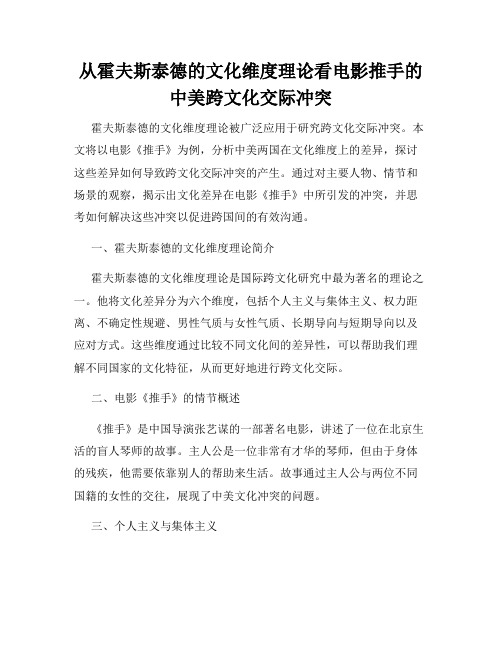
从霍夫斯泰德的文化维度理论看电影推手的中美跨文化交际冲突霍夫斯泰德的文化维度理论被广泛应用于研究跨文化交际冲突。
本文将以电影《推手》为例,分析中美两国在文化维度上的差异,探讨这些差异如何导致跨文化交际冲突的产生。
通过对主要人物、情节和场景的观察,揭示出文化差异在电影《推手》中所引发的冲突,并思考如何解决这些冲突以促进跨国间的有效沟通。
一、霍夫斯泰德的文化维度理论简介霍夫斯泰德的文化维度理论是国际跨文化研究中最为著名的理论之一。
他将文化差异分为六个维度,包括个人主义与集体主义、权力距离、不确定性规避、男性气质与女性气质、长期导向与短期导向以及应对方式。
这些维度通过比较不同文化间的差异性,可以帮助我们理解不同国家的文化特征,从而更好地进行跨文化交际。
二、电影《推手》的情节概述《推手》是中国导演张艺谋的一部著名电影,讲述了一位在北京生活的盲人琴师的故事。
主人公是一位非常有才华的琴师,但由于身体的残疾,他需要依靠别人的帮助来生活。
故事通过主人公与两位不同国籍的女性的交往,展现了中美文化冲突的问题。
三、个人主义与集体主义在霍夫斯泰德的理论中,个人主义与集体主义被认为是衡量文化差异的重要指标之一。
个人主义强调个体的独立、自由和竞争,而集体主义强调群体的合作、关系和互助。
在电影《推手》中,主人公的行为和价值观体现了中国社会的集体主义思想。
他与身边的人保持紧密联系,他们互相帮助和支持,以实现共同的目标。
然而,当主人公与来自美国的女性交往时,她们更多地关注个体利益,强调独立性和自我实现。
这种文化差异导致了交际上的冲突,使双方难以理解对方的行为。
四、权力距离权力距离是指一个社会中个体对于权威和权力分配的认可程度。
在高权力距离的文化中,人们相信权威的存在和不可质疑的地位;而在低权力距离的文化中,个人更注重平等和自由。
在电影中,主人公作为一个残疾人,他习惯于接受他人的帮助和指导。
这反映了中国社会较高的权力距离,人们更容易接受权威的指导和管理。
集体主义与个人主义

集体主义与个人主义———中美不同文化背景下价值观念的差异及其文化根源每个人,每个社会团体,每个社会阶层,每个国家都有自己独特的价值观念。
价值观通常指人们对于一些重要事物,一些基本行为准则的主观判断的基础,并以此来获取知识,掌握技巧,树立正确的世界观等等。
简而言之,价值观念属于主观意识形态范畴,它涉及人们对客观事物的看法以及对不同事物的取舍态度和标准。
比如说,在中国社会,人们提倡和推崇的是“为人民服务”的社会价值观念,而在美国,这一价值取向却几乎没有市场,美国人信奉的“先为自我,我再帮人” ;在中国人心目中,国家民族利益是至高无上的,其次是他们赖以生存的集体的利益,最后才会考虑自己的个人利益;可是在美国人看来,占第一位的是民主、自由和国家的利益, 占第二位的是对物质财富和个人幸福的追求,第三位才是热情好客以及对他人的帮助。
价值观念既属于主观意识范畴,就离不开历史和文化的影响,中美两国由于在政治、历史、地理风貌和经济形态等众多领域的差别,在对许多社会问题的看法和价值取向上存在着巨大的差异。
这种差异实际上反映的是各自文化渊源的差别。
在英语语言学习过程中,关于文化差异中国学习者感受最深的就是集体主义观念和个人主义观念的冲突。
本文将从这两种文化价值观所体现出的语言文化现象及其产生的历史文化根源进行剖析。
一、集体主义和个人主义及其语言文化反映所谓集体主义(collectivism) ,简而言之指的是一种强调集体和国家的重要性,强调集体利益应该凌驾于个人利益之上的文化价值观念。
它认为,人是集体中的一员,离开集体,个人几乎无所作为或者作用很小,所以社会中的每一个人必须重视合作和集体的力量,任何事情必须多为他人考虑,要珍视友谊和家庭。
个人主义(individualism) 与此相反, 认为个人虽然离不开社会集体,但是正是由于个人对自我利益和幸福的不断追求才最终推动了社会的前进, 所以在社会事务中应首先考虑个人的幸福和需要。
浅析跨文化交际下的个体主义和集体主义
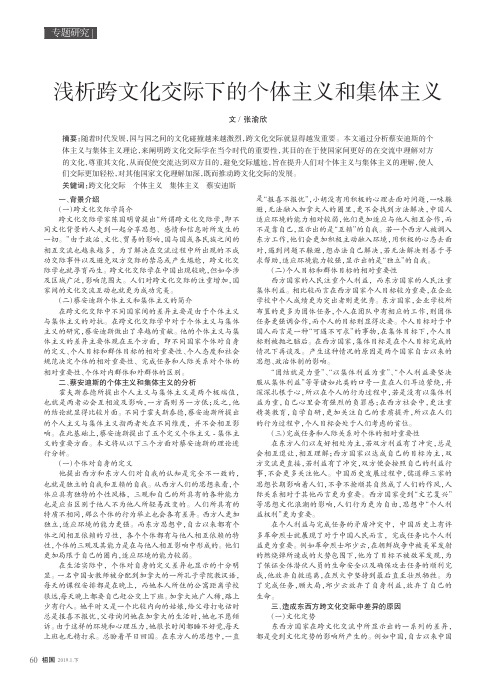
祖国2019.1.下摘要:随着时代发展,国与国之间的文化碰撞越来越激烈,跨文化交际就显得越发重要。
本文通过分析蔡安迪斯的个体主义与集体主义理论,来阐明跨文化交际学在当今时代的重要性,其目的在于使国家间更好的在交流中理解对方的文化,尊重其文化,从而促使交流达到双方目的,避免交际尴尬,旨在提升人们对个体主义与集体主义的理解,使人们交际更加轻松,对其他国家文化理解加深,既而推动跨文化交际的发展。
关键词:跨文化交际个体主义集体主义蔡安迪斯浅析跨文化交际下的个体主义和集体主义文/张渝欣一、背景介绍(一)跨文化交际学简介跨文化交际学家陈国明曾提出“所谓跨文化交际学,即不同文化背景的人走到一起分享思想、感情和信息时所发生的一切。
”由于政治、文化、贸易的影响,国与国或各民族之间的相互交流也越来越多,为了解决在交流过程中所出现的不成功交际事件以及避免双方交际的禁忌或产生尴尬,跨文化交际学也就孕育而生。
跨文化交际学在中国出现较晚,但如今涉及区域广泛,影响范围大。
人们对跨文化交际的注重增加,国家间的文化交流互动也就更为成功完美。
(二)蔡安迪斯个体主义和集体主义的简介在跨文化交际中不同国家间的差异主要是由于个体主义与集体主义的对抗。
在跨文化交际学中对于个体主义与集体主义的研究,蔡安迪斯做出了卓越的贡献。
他的个体主义与集体主义的差异主要体现在五个方面,即不同国家个体对自身的定义、个人目标和群体目标的相对重要性、个人态度和社会规范决定个体的相对重要性、完成任务和人际关系对个体的相对重要性、个体对内群体和外群体的区别。
二、蔡安迪斯的个体主义和集体主义的分析霍夫斯泰德所提出个人主义与集体主义是两个极端值,也就是两者必会互相波及影响,一方高则另一方低;反之,他的结论就显得比较片面。
不同于霍夫斯泰德,蔡安迪斯所提出的个人主义与集体主义指两者处在不同维度,并不会相互影响。
在此基础上,蔡安迪斯提出了五个定义个体主义-集体主义的重要方面。
跨文化交际第四章_集体主义vs个人主义归纳.ppt
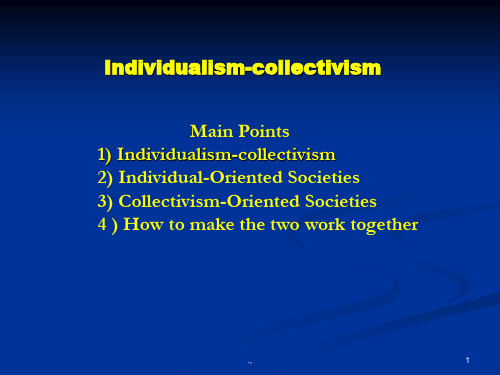
10
When they are friendly, they are very verbal and open, but they can be very critical toward enemies. Individuals like to debate issues but will withdraw and become defensive with somebody they don’t trust.
.,
11
When they are interested, they can be loud with lots of questions but they are likely to look away when they get bored.
.,12Βιβλιοθήκη The characteristics of individuals
.,
2
Individualism— being different
Collectivism—how much you can do for the group you are in
.,
3
Some countries, such as the United States, Canada, Great Britain, and the Netherlands, place a high value on individualism. There cultures emphasize the worth and dignity of the individual over the group, independence rather than interdependence, and relatively few social obligations.
跨文化交际
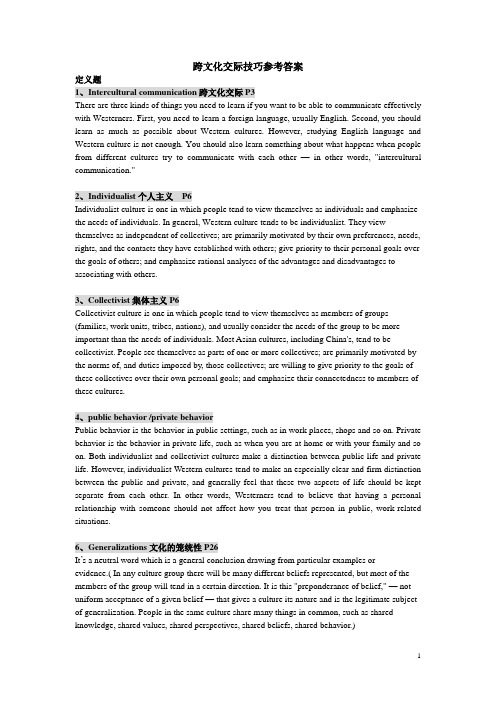
跨文化交际技巧参考答案定义题1、Intercultural communication跨文化交际P3There are three kinds of things you need to learn if you want to be able to communicate effectively with Westerners. First, you need to learn a foreign language, usually English. Second, you should learn as much as possible about Western cultures. However, studying English language and Western culture is not enough. You should also learn something about what happens when people from different cultures try to communicate with each other —in other words, "intercultural communication."2、Individualist个人主义P6Individualist culture is one in which people tend to view themselves as individuals and emphasize the needs of individuals. In general, Western culture tends to be individualist. They view themselves as independent of collectives; are primarily motivated by their own preferences, needs, rights, and the contacts they have established with others; give priority to their personal goals over the goals of others; and emphasize rational analyses of the advantages and disadvantages to associating with others.3、Collectivist集体主义P6Collectivist culture is one in which people tend to view themselves as members of groups (families, work units, tribes, nations), and usually consider the needs of the group to be more important than the needs of individuals. Most Asian cultures, including China's, tend to be collectivist. People see themselves as parts of one or more collectives; are primarily motivated by the norms of, and duties imposed by, those collectives; are willing to give priority to the goals of these collectives over their own personal goals; and emphasize their connectedness to members of these cultures.4、public behavior /private behaviorPublic behavior is the behavior in public settings, such as in work places, shops and so on. Private behavior is the behavior in private life, such as when you are at home or with your family and so on. Both individualist and collectivist cultures make a distinction between public life and private life. However, individualist Western cultures tend to make an especially clear and firm distinction between the public and private, and generally feel that these two aspects of life should be kept separate from each other. In other words, Westerners tend to believe that having a personal relationship with someone should not affect how you treat that person in public, work-related situations.6、Generalizations文化的笼统性P26It’s a neutral word which is a general conclusion drawing from particular examples or evidence.( In any culture group there will be many different beliefs represented, but most of the members of the group will tend in a certain direction. It is this "preponderance of belief," — not uniform acceptance of a given belief — that gives a culture its nature and is the legitimate subject of generalization. People in the same culture share many things in common, such as shared knowledge, shared values, shared perspectives, shared beliefs, shared behavior.)7、Stereotypes老套思路P26It is a derogatory word. It means that image, idea, character that has become fixed or standardized in a conventional form without individuality and is therefore false and shallow.( A way of thinking that does not acknowledge internal difference within a group, and does not acknowledge exception to its general rules or principles. These stereotypes are often based on accurate information but the problem is that stereotypes blind us to other, equally important aspects of a person's character or behavior. Stereotypes may have been created by direct experience with only one or two people from a particular group. Others are probably based on the second-hand information and opinion, output from the mass media, and general habits of thinking; they may even have been formed without any direct experience with individuals from the group. Yet many people are prepared to assume that stereotype is an accurate representation of all members of a specific group.)8、Hierarchy不同的等级权利P33Every society has hierarchy to some degree. In other words, some people have higher rank and more power than others, perhaps because they are older, stronger, wealthier, or have some kind of official position. On the other hand, however, most modern societies also believe that equality is a virtue, at least to some extent. So each culture needs to find its own balance between hierarchy and equality.1) Westerners generally have less respect for seniority — age, position and so forth — than would be the case in a collectivist culture.2) Western societies often try to limit the power of government officials.3) Westerners tend to have a somewhat suspicious and even negative view of power and authority.9、Culture shock文化冲击P36Culture shock is a feeling of being confused and overwhelmed by life in another culture. People who experience culture shock often feel fatigued, impatient and irritable. They may also begin trying to avoid interaction with foreigners, and even become increasingly critical and hostile toward them. Foreigners in China sometimes experience culture shock — and so do Chinese who go to live in other countries.10、Projected cultural similarity P48Projected cultural similarity is the tendency to assume that people from other cultures basically think and feel more the same way we do. In other words, we sometimes assume that while foreigners may look different, dress differently, and speak different languages, "inside we are all more or less the same". People from different culture assume they understand each other instead of asking each other what they think. Because they each expect the other person to react more or less the same way they would, they don't check to see whether or not the other person actually has the same feelings and reactions they would.11、Ethnocentrism 民族优越感P59"Ethnocentrism" is the tendency to think of one’s own culture as being at the center of the world and identify with one’s in-group and to evaluate out-groups and their members according to its standards; in other words, to assume that one’s own culture's way of thinking and acting is more natural, normal, and correct than the way people from other cultures think and act, and tend to view one’s own cultural values and ways of doing things as more real, or as the ‘right’ and natural values and ways of doing things.12、In-groups and out-groups P70In-Groups: “In-groups”are the people we have the most in common with and identify most closely with, such as our family, classmates, or co-workers. We also have larger in-groups such as people who are from our own region, religious group, ethnic group, or nation. In-groups are groups of people about whose welfare we are concerned, with whom we are willing to cooperate without demanding equitable returns, and separation from whom leads to discomfort or even pain. Out-groups: out groups are those groups of people who we do not identify with---people from other families, regions, ethnic groups, or nations. Out-groups are groups of people about whose welfare we are not concerned, and groups with whom we require an equitable return in order to cooperate.13、war stories P80The term “war stories” originally referred to the kinds of stories soldiers would tell after experiences in battle. Now “war stories” refers more generally to any stories people tell after strange or stressful experiences, including stories about unusual encounters with foreigners.问答题1、What are the similarity and difference between “Projected Cultural Similarity” and “Ethnocentrism”? P48(Ethnocentrism and projected cultural similarity are closely related, but the terms describe somewhat different phenomena. Ethnocentrism is taking one's own culture norms as the standard by which to judge people of other cultures. Projected cultural similarity is assuming that people of other cultures view things the same way you do.)“Projected Cultural Similarity”定义“Ethnocentrism”定义The similarity: both of them can not be avoided or overcame in intercultural communication. These two phenomena show that every country or nation consider their own culture as the center. Difference: PCS: people have the tendency to assume that other people from other cultural back ground basically think and feel more or less the same way as they do.E: people have the tendency to think their culture has the superiority to others’ and assume that their own culture’s way of thinking and acting is more natural, normal, and correct than the way people from other cultures’ think and act.2、Do unto others what you would have them do unto you P49先定义Projected cultural similarity要点:1. 先解释do to others what you would have them do to you (己所不欲勿施于人),并且这个行为符合PCS 2. 然后在本文化中,己所欲,施之于人,是一种美德,但是从Projected cultural similarity方面回答一下,因为在跨文化交际中,人们自认为其他不同文化的想的跟自己一样,所以自己觉得好的,对方也会觉得好,其实不然(自己发挥吧)The sentence means that it’s better not to do things to others what you don’t want others do to you. This behavior shows the phenomena “Projected cultural similarity”. In our cultural system, if you don’t like thing done to you, you just don’t impose on others. It’s a kind of virtue. But from the aspect of PCS, people just assume people from other cultures view things the same way we do. What we think is right, we consider others will think it is right, too. However, it just doesn’t work out like that. Because of different cultural background, we have different interpretations of everything happened .we can not expect others to think or act the same as we do.3、why would people project cultural similarity?p49问答题先定义Projected cultural similarity(1) projected cultural similarity is the tendency to assume that people from other cultures basically think and feel more or less the same way we do.(2) It is hard for people to imagine a perspective different from their own. It is effected by human nature, people are accustomed to self-centered. when they communicate with foreigners ,they usually assume that foreigners are similar to us(3) As we grow up and learn what is right and wrong,truth and false,normal and abnormal, and so forth, we naturally learn to view the world as our culture views it.The only to solve PCS is communication!4、conformity in western cultures1)”Loose ” cultures do not demand a high degree of conformity. In loose cultures, people have a relatively wide range of views as to what is considered normal behavior.“Tight” cultures ,in contrast, expect a relatively high degree of conformity. There is a clear consensus as to what is and is not acceptable behavior, and there is more pressure on people to conform to the norms of the cultures.(2)Chinese culture is tight culture ,and western cultures are loose cultures. So conformity in western cultures is less in Chinese culture.5、What factors lead to /contribute to looseness or tightness in culture?(加些自我发挥) P54 1. The degree of change in the population---the more people move, the more loose and individualist a society tends to be2. The density of the population—small dense societies tend to be collectivist, hence tighter. Large dense society tend to be more complex, hence not quite so tight--melting pot3. The number of choices available in society---the more choices available, the more room there is for individualism6、why does ethnocentrism cause difficulty in intercultural communication?在跨文化交际中,为什么民族优越论会导致很多麻烦?P59先定义ethnocentrismbecause we naturally feel that the ways and ideas of our culture are more natural and correct than those of other culture, we tend to use the norms of our own culture —our idea of what is good/bad, right/wrong, normal /abnormal — as standards when we judge the behavior of people from other cultures. So when we encounter foreigners who behave or think in ways that differ from our cultural norms, we too quickly tend to judge these other ways as strange, wrong, or bad.7、Why are in/out-groups a problem in intercultural communication?在跨文化交际过程中,为什么圈内和圈外造成重大麻烦P70“In-groups” are the people we have the most in common with and identify most closely with, such as our family, classmates, or co-workers. We also have larger in-groups such as people who are from our own region, religious group, ethnic group, or nation.“O ut-groups” are those groups of people who we do not identify with---people from other families, regions, ethnic groups, or nations.(1)We generally have more positive feelings toward members of our in-groups than we do toward outsiders. We trust insiders more.(2)We tend to have a stronger sense of obligation to insiders than to outsiders. We feel it’s right to help insider more …(3)We tend to judge in-groups and out-groups by different standards. To insiders. More generous, to outsiders, more critical, suspicious, more harsh judgmentsSo the ties of goodwill and trust between in-groups and out-groups are often relatively weak, and they break easily when there is conflict or misunderstanding.8、How do Chinese people treat in-group and out-group in line with culture back?根据中国的文化背景,中国人是怎样对待圈内人和圈外人的?P77Chinese generally have a high sense of loyalty and obligation to their in-groups, and will often go to great lengths to help people they consider members of their in-groups; however, they feel less obligation to outsiders.Chinese often view outsiders who come to china as guests, and give them much special treatment. In part, this is because Chinese view guests as a kind of in-group and tend to treat in-group members very well.9、Never a borrower or a lender be. P79“Never a borrower or a lender be”, this sentence means that it is best to not lend [money] to other people and to not borrow from other people. When we lend something we risk losing both the thing we lend and the friendship with that other person. To begin with, it is because westerners are in Individualist Cultures. Individualists tend to view themselves as individuals and to emphasize the needs of individuals. Individualists feel less obligation to others, whether they are in-groups or out-groups. Secondly, because of their characteristics, their individualism, western people tend to be very independent and self-reliant. They will always solve their problems by themselves. So they don’t want others to rely on them, either.10、Characteristics of war stories P82 先定义war stories(1)One reason we tell such war stories is to get reassurance that our interpretation of the encountermakes sense.(2)In war stories, we generally portray ourselves as the hero or victim, and we often paint theforeigner as the "bad guy." Because we want to get sympathy from our listeners, we tend to emphasize how unreasonable the behavior of the foreigner was, and how reasonable our own behavior was(3)We generally tell war stories to people who are likely to sympathize with us, usually peoplefrom our own culture rather than outsiders(4)As we tell war stories, we often generalize from one specific experience to groups of foreignersas a whole。
如何处理跨文化交际中的问题

如何处理跨文化交际中的问题跨文化交际,简单来说就是不同文化背景的人之间的交往与沟通。
在现代社会中,跨文化交际日益频繁,无论是在商业、学术、旅游等领域,都需要我们具备跨文化交际的能力。
但是,由于文化差异的存在,跨文化交际中也会出现各种问题。
本文将从几个方面探讨如何有效处理跨文化交际中的问题,并提高跨文化交际的能力。
一、理解文化差异不同文化背景下的人会有不同的价值观、信仰、行为规范等等。
比如,在西方国家,人们普遍注重个人主义、自由、平等、竞争等,而在亚洲国家,人们普遍注重集体主义、和谐、尊重长辈、团结合作等。
因此,在跨文化交际中,首先需要理解文化差异,尊重不同文化,敢于提问和分享观点,学会接纳不同文化下的习惯和信仰。
二、注意语言和文化背景语言的使用和文化背景密不可分。
在跨文化交际中,我们需要注意使用语言是否得体,是否会引发误解或冲突。
比如,在英语中,“nice”表示“好的、良好的、友好的”等,但在中文中,解释更为细分,如“漂亮的、好看的、好的、友好的、和蔼的”等。
如果对“nice”的词义不明确,使用不当,就会导致误解和冲突。
因此,在跨文化交际中,还需要积累知识,了解不同文化下的语言使用、礼仪等。
三、加强沟通能力沟通是跨文化交际的核心。
在跨文化交际中,沟通不仅仅是语言的沟通,还包括身体语言、面部表情、姿态等各种语言之外的交流方式。
比如,在亚洲国家,人们往往不喜欢直接拒绝对方,他们更喜欢模棱两可的说法,而在欧美国家,直接表达和坦率被认为是比较正常的做法。
因此,要加强沟通能力,磨练语言技巧,学习分辨不同语境,灵活运用不同的沟通方式。
四、理解非语言交流除了语言的交流,非语言交流也是一种非常重要的沟通方式。
在跨文化交际中,非语言交流包括身体语言、面部表情、肢体动作等。
不同文化背景下的非语言交流差异很大,因此需要尤其注意。
比如,中国人往往不喜欢和陌生人直接目光相对,而在美国,则会被认为是不诚实的表现。
因此,要学会理解不同文化下的非语言交流,以避免误解和冲突。
跨文化交际第四章集体主义vs个人主义
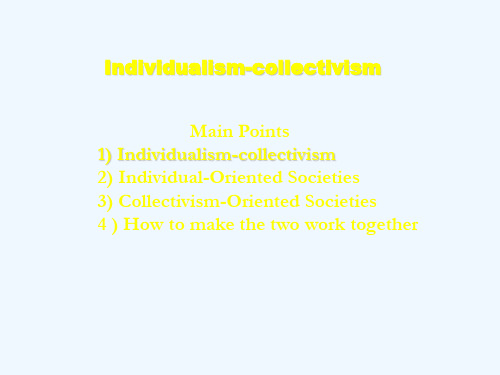
1. Individual-Oriented Societies
Individualistic culture believes that people are supposed to take care of themselves and remain emotionally independent of groups, organizations, or other collectivities. Selfemphasis is important, even in building friendships.
Individualism— being different
Collectivism—how much you can do for the group you are in
Some countries, such as the United States, Canada, Great Britain, and the Netherlands, place a high value on individualism. There cultures emphasize the worth and dignity of the individual over the group, independence rather than interdependence, and relatively few social obligations.
1) The ideal of the individual is deeply rooted in the social, political, and economic institutions of such societies as the United States and England. The individual is the source of moral power, totally competent to assess the effects of his or her own actions, and is expected to be responsible for those actions.
专业的跨文化交际理论

专业的跨文化交际理论前言跨文化交际是指在不同语言、文化背景下进行沟通和交流的过程。
在全球化进程日益加快的今天,跨文化交际能力变得越来越重要。
为了更好地理解和应对不同文化背景下的交流挑战,学者们不断研究并提出了专业的跨文化交际理论。
本文将介绍几个具有代表性的跨文化交际理论,对其主要观点进行阐述。
一、霍夫斯泰德文化维度理论霍夫斯泰德文化维度理论是跨文化交际中最著名的理论之一,由荷兰心理学家霍夫斯泰德在20世纪80年代提出。
该理论主要通过对不同国家文化的比较,分析了影响跨文化交际的六个维度,即权力距离、不确定性规避、个人主义与集体主义、男性气质与女性气质、长期导向与短期导向以及放纵与禁制。
其中,权力距离指的是社会中不同阶层之间的权力分配程度;不确定性规避反映了社会对不确定性的接受程度;个人主义与集体主义衡量了个人与群体之间的关系;男性气质与女性气质体现了社会对性别角色的认知;长期导向与短期导向揭示了不同文化对未来与现在的关注;而放纵与禁制则描述了社会对自发性的态度。
通过了解不同国家在这六个维度上的特点,我们可以更好地理解和应对跨文化交际中的文化差异。
例如,当我们与一个来自权力距离较大的国家的人进行交流时,我们需要注意避免使用直接的语言和姿势,以避免冒犯对方。
二、融入理论融入理论是由美国学者德尔·赫斯特和让·吉尔·马尔蒙提出的。
该理论认为,跨文化交际的主要目标是尽可能地融入对方文化,以达到有效的沟通和交流。
融入理论主张,人们可以通过扮演类似对方的角色,学习和模仿对方的行为方式、礼仪规范、语言等,以增加在跨文化环境中适应性和理解力。
同时,融入理论也提倡拓展自己的认知视野,接纳和尊重不同文化的差异,以减少误解和冲突。
三、社会认知理论社会认知理论是由美国心理学家克里斯·布鲁纳提出的,该理论认为人们对现实世界的理解和解释是通过社会互动和文化学习来形成的。
在跨文化交际中,人们会根据自己的文化背景和经验,对对方的言行进行认知和解读。
国际汉语教师资格证考试 冲刺课_第10课第11课_跨文化交际

低语境文化和高语境文化的不同交际特点: 对于邻居夜晚音乐声音太大而影响自己休息这件事,低语 境的美国人可能直接用言语表达不满:“已经11点了,你们这 么大音量的歌剧音乐打扰了我的睡眠。请立即把音乐关掉。明 天我有一个重要的工作面试,我需要睡个好觉,因为我非常需 要这份工作去交房租。而对于邻居家孩子弹钢琴打扰了自己休 息,高语境文化的日本人则采用了非常委婉、间接的表达方式: “你的女儿上钢琴课了吧?我很羡慕,因为你可以为她的才能 而自豪。你一定期望她未来成为一个钢琴家。她的热情给我留 下了很深的印象。她每天练习得这么努力。不停地练习,一直 到深夜。’’而孩子的家长立即回答道:“不是,一点也不是。 她只是个初学者,我们还不知道未来怎么样。我们没有意识到 您听到她弹琴的声音。真对不起,噪音打扰您了。”
跨文化意识指的是在跨文化交际中对文化间的差 异具有敏感性,善于发现不同甚至矛盾,并做到科学 的判断和理性的分析,处理时自觉排除“种族中心主 义”“刻板印象”“偏见”的干扰,有效得体地解决 问题。
1 集体主义与个人主义
在集体主义社会中,成员之间关系紧密,具有凝聚力, 群体目标高于个人目标,在文化方面主张收敛自我;
2 尊重别国文化
对学生的母语文化有比较全面的了解,对于不同文化之间
的异同能够敏锐地捕捉,从而减少文化冲突。 如在中国的传统文化中,“狗”会使人联想到“狼心狗
肺”“狗仗人势”等词语,而在西方国家,狗被看成家庭成员, 具有正面意义;用“猫”造句,中国学生可能会说“她像猫一 样安静”,而西方学生可能会说“她像猫一样性感”;中国人 喜欢双数,结婚挑双数的日子,礼物也是双数的,但日韩学生 更喜欢单数,因为日本人认为双数容易拆分,为避免离婚,他 们在参加婚礼时一定要准备单数的红包;韩国人认为单数是阳 数,尤其喜欢“三”,但在越南文化中“三”又是不吉利的数 字。
跨文化交际案例集体主义文化和个人主义文化课件

各国的福利政策存在 差异,例如北欧国家 的福利水平较高,而 南欧国家的福利水平 相对较低。
在跨文化交际中,需 要对各国的福利政策 进行了解和研究,以 便更好地适应和融入 当地社会。
03
个人主义文化案例
案例一:美国社会的个人主义价值观
总结词
美国社会的个人主义价值观强调个人的独立、自主和自我实 现,鼓励个人奋斗和竞争,以及对个人权利和自由的尊重。
适应能力 面对不同文化背景的人,可能需要调整自己的交际方式,以更 好地适应对方的交际风格。
对未来研究的展望
深入探讨
可以进一步深入研究集体主义和个人主义文化对跨文化交 际的具体影响,例如在沟通策略、决策方式、团队合作等 方面的差异。
跨学科合作 鼓励跨学科的研究合作,例如心理学、管理学、社会学等 领域的学者可以与语言学、传播学等领域的学者合作,共 同探讨跨文化交际的问题。
详细描述
澳大利亚的社会文化中强调个人的独立和自主,鼓励人们自我决策和追求自己的 目标。这种独立精神也体现在澳大利亚的教育、商业和政治领域。然而,这种独 立精神也可能带来一些问题,如社会联系的减弱和孤独感的增加。
案例三:加拿大的社会保障制度
要点一
总结词
要点二
详细描述
加拿大的社会保障制度强调个人的权利和需要,通过 政府提供的福利和服务来满足这些权利和需要,以及 对平等和公正的追求。
跨文化交际
指不同文化背景的人们之间的交流 和沟通。
集体主义文化与Biblioteka 人主义文化的对比0102
03
价值观
集体主义文化重视集体价 值观,个人主义文化重视 个人价值观。
社会关系
集体主义文化强调社会联 系和互相依赖,个人主义 文化强调个人独立和自主。
【跨文化交际】东西方差异之个人主义和集体主义分析
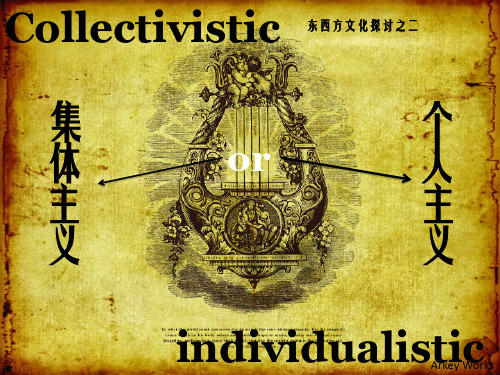
集体主义有积极和消极两方面的后果。
Arkey Works
积极方面:中国人谦虚、谨慎,相互合 作,讲究集体主义、爱国主义,成功之 时把功劳归于集体、环境和他人帮助。 消极方面:缺乏个人进取精神,缺乏个人 竞争意识,缺乏创造精神,过于看重“关 系”。
Arkey Works
个人主义
他人取向是群体取向的伸延,表现在做事情时,首 先考虑别人怎么看。这样在人际交往中重视面子和 面子功夫,追求一种和谐的人际关系。因此,人们 见面时常说“你吃饭了吗” ,目的不是要探求对方 的隐私,只是想拉近距离,营造一种亲密关系而已。 集体主义强调集体的观点、需要、目标,强调社会 规范、责任而不是个人享乐,强调集体内部的共同 信仰和共同合作。个人的情感依赖于集体,通过对 集体的绝对忠诚,人们期盼得到集体的帮助。
Arkey Works
二者比较
Arkey Works
集体主义和个体主义在法治上的差异
在统治国家方面,中国传统所重视的是礼和伦 理。在我国,尤其是古代,那些先贤们对礼数都非 常重视,倡导人人都要谨守礼数。因此,在人际关 系方面,他们制定了五达道——君臣、父子、夫妇、 兄弟、朋友,用来倡导人们维持善良的人格和营造 融洽的社会氛围;在社会阶层管理方面,还用三达 德——智、仁和勇来约束人们的行为,并以此来倡 导对“天地君亲师”的尊崇;在治国方面,他们主 张运用四维——礼、仪、廉和耻来维护国家的长治 久安,因为在他们看来,如果四维不张,那么国家 就有可能会面临灭亡。就这样,当这些传统的礼俗 弥漫于整个社会上空的时候,这个社会自然而然就 会被笼罩在一种无形的道德约束力之下。
Arkey Works
集体主义和个体主义在道德上的差异
中国人的道德观念是以“人伦”为本的,而“荣辱与 共”、“休戚相关”则是这种人伦道德的基本精神。这主 要体现在中国社会对伦理生活的一贯重视。另外,中国社 会比较注重人与人之间那种互相依存的关系。一直以来, 中国强调的都是“和谐 大一统”的思想。 而在西方国家,由于受“天赋人权”思想的影响, 所以他们眼中的道德是以不侵犯别人的权益为准则的。即 只要你不侵犯别人的利益,哪怕你再胡作非为,也没有什 么道德丧失可言,更不会有人拿道德来约束你。另外,因 为受到国家极端流行的个人主义的影响,他们非常重视个 人的权益和自由,并抓住机会尽可能地发挥自己的独特性。
最具影响力的四个跨文化交际框架

最具影响力的四个跨文化交际框架1. 文化维度理论(Cultural Dimensions Theory)文化维度理论是荷兰学者霍夫斯泰德(Geert Hofstede)提出的,它通过对不同文化在价值、行为和信念方面的差异进行比较,帮助人们理解不同文化间的交际方式。
该框架介绍了几个重要的文化维度,包括个人主义与集体主义、权力距离、不确定性规避、男性气质与女性气质等。
通过对这些维度的了解,个人可以更好地适应不同文化背景下的交际环境,避免误解和冲突。
2. 沃尔夫(Edward T. Hall)的高/低上下文文化沃尔夫提出的高/低上下文文化是指个人在交际中传递信息所依赖的环境背景。
高上下文文化认为信息的理解需要依赖于上下文和非言语因素,而低上下文文化更注重直接、明确的语言表达。
这个框架可以帮助人们理解不同文化在信息传递中的差异。
在高上下文文化中,交际者需要更多地依赖于非言语因素,如肢体语言、面部表情等来理解对方的意思。
而在低上下文文化中,言语表达更为重要,非言语因素的作用相对较小。
3. 文化智商(Cultural Intelligence)文化智商是指个人在跨文化环境中有效适应和交流的能力。
它包括对不同文化的了解和尊重,以及在交际中的灵活性和适应能力。
通过提高文化智商,个人可以更好地应对不同文化背景下的交际挑战,避免误解和冲突。
这种框架强调了跨文化交际中的自我意识和自我调整能力的重要性,以及持续研究和发展的态度。
4. 多元视角(Multiple Perspectives)多元视角是指在交际中积极采纳多种不同文化的观点和态度。
它强调不同观点之间的对话和理解,以及避免以己度人的偏见。
这个框架可以促进跨文化交际中的相互尊重和开放性,帮助个人更好地理解和欣赏不同文化的差异。
通过采纳多元视角,人们可以促进有效的合作和交流,从而达到更好的结果。
以上是最具影响力的四个跨文化交际框架,它们都能帮助个人在跨文化环境中实现更好的交际效果,并建立互相理解和尊重的关系。
跨文化交际中的中美文化差异

跨文化交际中的中美文化差异随着全球化的推进,跨文化交际越来越成为日常生活和工作的重要组成部分。
在这个背景下,理解和处理好中美文化差异对于促进有效沟通和建立良好关系具有重要意义。
本文将探讨中美文化差异的表现、影响及应对措施,以增进人们对跨文化交际的理解。
价值观方面:中美两国在价值观上存在明显差异。
美国强调个人主义和自由,注重个人权利和独立思考。
而中国注重集体主义和和谐,强调群体利益和社会秩序。
语言方面:中文和英文是两种截然不同的语言,具有各自独特的文化内涵。
例如,中文里的成语、谚语和典故等,往往没有直接对应的英文表达,这给跨文化交流带来一定难度。
习俗方面:中美两国在社交礼仪、饮食习惯、节日庆祝等方面也存在显著差异。
例如,中国人注重礼尚往来,喜欢在饭桌上交流;而美国人则更注重隐私和独立,不轻易接受礼物。
中美文化差异对跨文化交际产生的影响主要体现在以下方面:沟通难度:由于价值观、语言和习俗的差异,中美两国在沟通时容易产生误解和障碍,影响交流效果。
文化冲突:不同的文化背景可能导致人们在处理问题时产生分歧和冲突,影响双方的关系。
为了有效应对中美文化差异,以下措施值得借鉴:学习对方的文化特点:了解对方的文化背景、价值观、语言和习俗,以便在交流中更好地理解和适应。
适应文化差异:尊重对方的文化习惯,不轻易评价和批评,而是以开放的心态去适应和接受。
中美文化差异是跨文化交际中不可忽视的重要因素。
为了确保有效的沟通和建立良好的关系,我们应当深入了解和尊重这种差异。
通过学习对方的文化特点、适应文化差异等措施,我们可以更好地应对中美文化差异带来的挑战。
在全球化的背景下,对中美文化差异的理解和处理好对对于促进有效沟通和建立良好关系至关重要。
随着全球化的推进,跨文化交际越来越成为日常生活和工作的重要组成部分。
在这个背景下,理解和探讨中美文化价值观的差异对于促进有效沟通和减少误解具有重要意义。
本文将从中美文化差异的历史、文化传承、文化交流等方面进行分析,并对比两种文化价值观的优劣之处,最后提出建议。
- 1、下载文档前请自行甄别文档内容的完整性,平台不提供额外的编辑、内容补充、找答案等附加服务。
- 2、"仅部分预览"的文档,不可在线预览部分如存在完整性等问题,可反馈申请退款(可完整预览的文档不适用该条件!)。
- 3、如文档侵犯您的权益,请联系客服反馈,我们会尽快为您处理(人工客服工作时间:9:00-18:30)。
矿产资源开发利用方案编写内容要求及审查大纲
矿产资源开发利用方案编写内容要求及《矿产资源开发利用方案》审查大纲一、概述
㈠矿区位置、隶属关系和企业性质。
如为改扩建矿山, 应说明矿山现状、
特点及存在的主要问题。
㈡编制依据
(1简述项目前期工作进展情况及与有关方面对项目的意向性协议情况。
(2 列出开发利用方案编制所依据的主要基础性资料的名称。
如经储量管理部门认定的矿区地质勘探报告、选矿试验报告、加工利用试验报告、工程地质初评资料、矿区水文资料和供水资料等。
对改、扩建矿山应有生产实际资料, 如矿山总平面现状图、矿床开拓系统图、采场现状图和主要采选设备清单等。
二、矿产品需求现状和预测
㈠该矿产在国内需求情况和市场供应情况
1、矿产品现状及加工利用趋向。
2、国内近、远期的需求量及主要销向预测。
㈡产品价格分析
1、国内矿产品价格现状。
2、矿产品价格稳定性及变化趋势。
三、矿产资源概况
㈠矿区总体概况
1、矿区总体规划情况。
2、矿区矿产资源概况。
3、该设计与矿区总体开发的关系。
㈡该设计项目的资源概况
1、矿床地质及构造特征。
2、矿床开采技术条件及水文地质条件。
